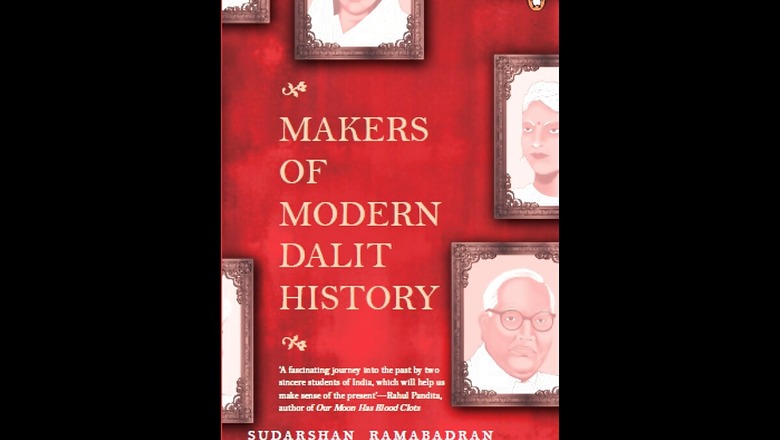
views
Kanshiram, considered the messaiah of Dalits after Ambedkar, was born on 15 March 1934 in a Dalit Chamar family in the Pirthipur Bunga village, Khawaspur, in the Ropar district of Punjab. He grew up with a love for sports, especially kabaddi and wrestling. Kanshiram studied at the government primary school in Malkapur, which was 2 kilometres from his village. Here he experienced the discrimination that Dalit children faced, such as having different pots for drinking water. Kanshiram was then moved to Islamiya School and the DAV Public School, where he completed his education. He graduated in 1956 with a BSc degree from the government college in Ropar. Kanshiram then went to the staff college in Dehradun for higher studies, where he also prepared for the Public Service Commission exams and worked with the Geological Survey of India. In 1957, Kanshiram joined the High Energy Materials Research Laboratory (renamed the Explosives Research and Development Laboratory in 1960) in Poona (now Pune) as a research assistant.
After working there for five years, his life changed course due to one incident. The laboratory used to be closed on Buddha and Ambedkar jayantis. However, his upper-caste colleagues replaced these two days with jayantis for Bal Gangadhar Tilak and Gopal Krishna Gokhale. The lower-caste staff members were against this move but did not have courage to protest. But with the help of a Class IV employee, Kanshiram took the matter to the then defence minister, Yashwantrao Chavan, who ordered an inquiry into the matter and the two days were reinstated.
It is at this point in his life that Kanshiram started reading the works of social reformers like Mahatma Jyotiba Phule and Ambedkar, which made him understand upper-caste hegemony more clearly and realize that the country’s administration comprised only 15 per cent of its entire population. He later understood that unless Dalits consolidated themselves into a single community, they would fail at staking a claim to India’s governance and administration.
He resigned from his job and joined the Republican Party of India and also formed the Minority Communities Employees Association. Soon after, his political career began, with the Dalit Shoshit Samaj Sangharsh Samiti (also known as DS-4) and the All-India Backward and Minority Communities Employees Federation (BAMCEF), which had the slogan: ‘Become educated, become consolidated and struggle.’ He later went on to form the
BSP on 14 April 1984. Kanshiram looked at the BAMCEF and the DS-4 as think tanks for the formation of the BSP. Kanshiram travelled extensively within the country to talk about the cause he stood for and the sociopolitical mission that he had armed himself with. In one of his interviews, he says he has criss-crossed the country at least twice. He also travelled to Japan, Malaysia and the United Kingdom to espouse social equity and the emancipation of Dalits.
With the passage of time and with the growing popularity of DS-4 and the BAMCEF, Kanshiram realized that the creation of a political platform was the next step to ensuring political representation of the Dalits and the backward communities. The BSP was launched in 1984, on the birth anniversary of Ambedkar, 14 April. This is when, for the first time since Independence, reservation for the OBCs was being discussed by the Mandal Commission. In 1979, the Morarji Desai government set up the Mandal Commission to identify backward classes and address caste-based discrimination. The Commission recommended 27 per cent reservation for OBCs for jobs under the central government and public-sector undertakings. Kanshiram seized the opportunity and galvanized the Dalits and the OBCs as a consolidated political force. The BSP led the pro-Mandal movement. Thousands of party workers, including young men, women and senior citizens, courted arrest in these demonstrations. The All India Revolt against Political Slavery was a movement that was launched in the same year as a platform to unify the OBCs and Dalits to help them realize their political worth as a formidable voting bloc. Needless to say, the BSP had the required momentum and, fortunately for the party, the general elections were announced in 1984. Kanshiram’s efforts bore fruit in the electoral performance of a nascent BSP in Uttar Pradesh. The BSP, then barely a year old, contested from nine states and three union territories, and got a formidable 10 lakh votes in the general elections that year, of which more than 6 lakh votes were polled by the party in Uttar Pradesh alone. Kanshiram realized that Uttar Pradesh, when it was undivided, used to send the highest number of MPs to the Lower House and performing well in the state was going to be the perfect example of capturing political power through social engineering.
There are also several reasons behind Kanshiram’s selection of Uttar Pradesh, and not Punjab, as his karmabhoomi (chosen place of work). First, caste-based discrimination was not as pronounced in Punjab as it was in Uttar Pradesh then. On the other hand, Punjab has also had a number of social-reform movements, given the prevalence of Sikhism in the state. As of 2011, Punjab had the highest population of SCs, constituting 29 per cent in the country. There are thirty-seven loosely organized caste groups within the Dalit community in the state, many of which refuse to be clubbed together. Although Kanshiram did try to galvanize a movement in Punjab through the BSP, unfortunately he could not achieve what he had set out to do—galvanize the bahujan samaj as a strong political force. On the other hand, the Dalits in Punjab had improved their economic situation through jobs. It was Uttar Pradesh where identity was strongly based on social origin. The Jatavs were dominant among the SCs, constituting 54.23 per cent of the total SC population.
Kanshiram wrote a book in 1982 called The Chamcha Age: An Era of the Stooges, in which he laid out the philosophical foundation of the BSP. By chamcha he meant the Dalit leaders in mainstream political parties who, in his opinion, were compromising the interests of the community to forward their personal political careers. In a no-holds-barred attack, Kanshiram says:
After the sad demise of Babasaheb Dr. B.R. Ambedkar in 1956, tools, agents and stooges of the high caste Hindus are found in abundance, not only in the political field but also in every field of human activity and relationship. Initially these tools, agents, and stooges were visible only to Dr. Ambedkar and the discerning eyes. Later, they were to be detected by the intelligentsia. But today, these tools, agents, and stooges are so much a common factor of daily life, that they can be easily detected by the common man in public. The common man has his own terminology. In his terminology, a tool, an agent, or a stooge is termed as Chamcha. And in this book, I have decided to use the common man’s terminology. To my mind, it will be fruitful to use common man’s terminology when we fight for his cause.
Apart from developing local committees and aiding organizational strength at the grass-roots level, Kanshiram ensured the cultural re-appropriation of local deities, war heroes, social reformers and soldiers of the Dalit community. Guru Ravidas, Rani Jhalkaribai, Uda Devi and others fit into the narrative of politics that Kanshiram espoused.
Kanshiram’s larger objective was the consolidation of the Dalit vote bank. While he minced no words when he termed some of his own Dalit brethren ‘chamchas’ or stooges in the hands of the upper caste, he did not let his relationship with other Dalit leaders suffer because of this view of his.
The nation lost Kanshiram on 9 October 2006, after a series of complications arising from blood pressure, diabetes and a brain stroke. With his death, a major movement in the history of post-Independence Dalit politics came to an end. Many important politicians, including the then prime minister, Manmohan Singh, several Congress leaders and even his bete noires Ramvilas Paswan and V.P. Singh paid their respects.
Kanshiram will always be remembered by his slogans. One that especially remains entrenched in the mind and imagination of Dalit activists is ‘Jiski jitni sankhya bhari uski utni hissedari’, implying that the road to the equitable distribution of wealth and national resources can only be computed on the basis of representation and numbers.
‘I will never get married, I will never acquire any property, I will never visit my home, I will devote and dedicate the rest of my life to achieve the goals of Phule-Ambedkar movement,’ Kanshiram used to say. Such was his commitment to public life that he contemporized the learnings of Ambedkar and Phule and was single-handedly able to galvanize the Dalits for concrete political action in pursuit of representation.
In his pragmatic style, Kanshiram sought to restore the lost self-esteem of the Dalits. Until a casteless society was formed, Kanshiram wanted his community to strive to achieve respectable positions in society through political power—and this would be the Dalit war strategy. According to Kanshiram, caste was a double-edged sword that he wanted to use in a way that benefited the Bahujans and destroyed upper-caste hegemony at the same time.
However, there were differences between Ambedkar’s and Kanshiram’s approaches when it came to this belief. In Kanshiram’s own words:
In 1962–63, when I got the opportunity to read Ambedkar’s book Annihilation of Caste, then I also felt that it is perhaps possible to eradicate casteism from the society. But later on when I studied the caste system and its behaviour in depth, gradually there was a modification in my thoughts. I have not only gained knowledge about caste from the books but from my personal life too. After understanding its functions in Indian society, I have stopped thinking about the annihilation of caste.
An important part of Kanshiram’s beliefs was that he mooted the idea of Dalits having their own media, that is, developing a Bahujan media both in English and in Hindi. Another difference was the fact that he learnt from being among the people, from first-hand experiences, from his own life and from the lives of those he met. He said, ‘Ambedkar learnt from the books but I have learnt from my own life and people. He used to gather books, I tried to gather people.’
Kanshiram, a democrat at heart, had a vision that was all-inclusive. If Ambedkar framed the Constitution, Kanshiram built a solid political infrastructure for the Dalits to ensure their political empowerment.
Read all the Latest News, Breaking News and Coronavirus News here. Follow us on Facebook, Twitter and Telegram.




















Comments
0 comment